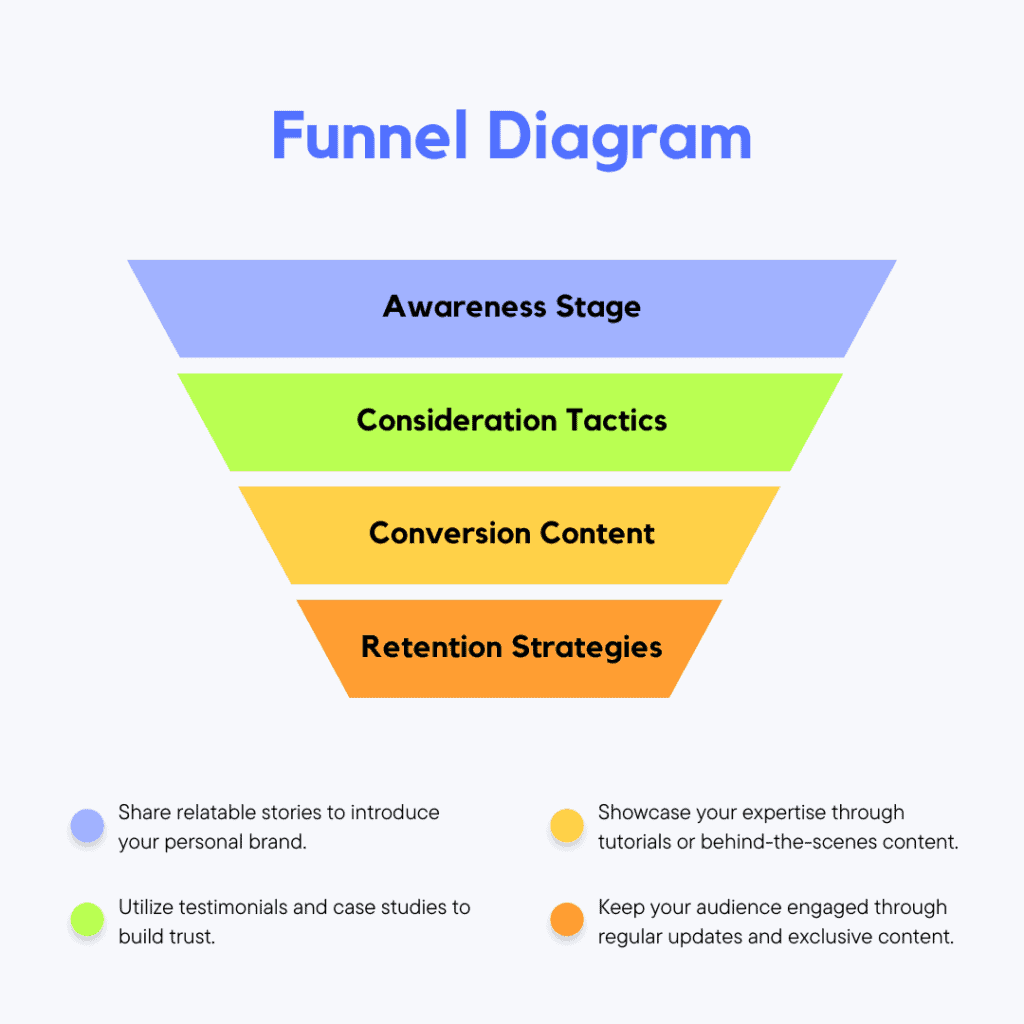Understanding Marketing Funnels: The Basics
What is a Marketing Funnel?
When you hear ‘funnels in marketing’, think of a journey. It’s the path your client takes from first hearing about you to becoming a loyal customer. Picture a funnel: wide at the top, narrow at the bottom. That’s how it works – starting broad, then getting more specific.

The Stages of a Marketing Funnel
Every marketing funnel has stages. Think of them as steps on a ladder, each taking your client closer to the final decision. First, there’s ‘Awareness’, where potential clients learn about your services. Next is ‘Interest’, where they start considering you. Then ‘Decision’, where they’re close to choosing you. Finally, ‘Action’, where they become your client.
Why Funnels Matter in Your Marketing Strategy
Funnels in marketing are crucial. They help you understand your client’s mindset at each stage. This understanding lets you provide the right information at the right time, guiding them smoothly to choosing your services. It’s about making the journey as easy and informative as possible for them.
Crafting Your First Marketing Funnel
Start by defining your target audience. Who are they? What do they need? Then, map out your funnel stages, tailoring your message for each stage. Use different tactics, like social media for awareness and personalized emails for decision-making. It’s about delivering the right message at the right time.
Maximizing the Effectiveness of Your Funnel
To make your funnel effective, track everything. Which emails get opened? What content gets the most clicks? Use this data to refine your funnel. It’s a constant process of testing, learning, and improving. The more you understand your funnel, the better you can guide your clients through it.
The Power of Understanding Funnels
Understanding funnels in marketing is a powerful tool. It’s about guiding potential clients on a journey, making each step clear and persuasive. With a well-planned marketing funnel, you can turn strangers into loyal clients, one stage at a time. Remember, a good funnel is about understanding and meeting your client’s needs every step of the way.
Building Effective Funnels for Financial Services
Tailoring Funnels to Financial Clients
In financial services, building effective funnels in marketing is about understanding your client’s unique needs. It’s not a one-size-fits-all strategy. Your funnel should reflect the specific journey a potential client takes from discovering your services to becoming a loyal customer.
Initial Attraction: Grabbing Attention
The first step in your funnel is to attract attention. This could be through engaging online content, targeted ads, or informative webinars. The key here is relevance. Your materials should speak directly to the common financial needs and concerns of your target audience, drawing them in.
Nurturing Interest: Providing Value
Once you’ve got their attention, it’s time to nurture that interest. Offer valuable resources like financial planning guides, market analysis reports, or helpful newsletters. This stage is about establishing trust and demonstrating your expertise in financial services.
Conversion: Turning Interest into Commitment
The conversion stage is where potential clients decide to choose your services. Here, personalized communication is crucial. Follow-up emails, one-on-one consultations, or tailored investment proposals can make all the difference. Show your clients that you understand and can meet their financial goals.
Focusing on Client Relationships
Remember, a funnel doesn’t end at conversion. Maintaining and nurturing client relationships is essential. Regular check-ins, updates on financial news, and ongoing support can turn a one-time client into a long-term advocate for your services.
Measuring and Tweaking Your Funnel
An effective funnel is always evolving. Use analytics to track how clients move through your funnel. Where do they drop off? What content do they engage with most? Continuously refine your strategies based on this feedback to make your funnel more effective.
Creating effective funnels in marketing for financial services is both a science and an art. It requires a deep understanding of your clients, a strategy tailored to their journey, and an ongoing commitment to nurturing relationships. With the right approach, your marketing funnel can become a powerful tool in growing your financial advisory business. Remember, a successful funnel is all about guiding the client smoothly from awareness to loyalty.
Optimizing Your Funnel for Maximum Conversion
Fine-Tuning Each Stage of the Funnel
To optimize funnels in marketing, especially in financial services, you need to fine-tune each stage for maximum impact. This involves tailoring your approach to ensure that each step in the funnel smoothly leads to the next, keeping potential clients engaged and moving forward.
Capturing Attention: The Awareness Stage
At the top of the funnel, your goal is to capture attention. Use eye-catching content that resonates with your audience’s financial interests and needs. Think informative blog posts, insightful videos, or engaging social media campaigns. The key is to make a strong first impression that piques curiosity and encourages further exploration.
Stoking Interest: The Consideration Stage
Now that you’ve got their attention, it’s time to stoke the fires of interest. This middle stage of the funnel is all about showcasing your value and expertise. Provide detailed guides, case studies, or webinars that delve deeper into financial topics. The content should be compelling enough to make them consider your services as a viable solution to their needs.
Sealing the Deal: The Decision Stage
The decision stage is crucial. This is where your leads decide whether to take the plunge. Here, personalized communication is key. Reach out with tailored emails, offer free consultations, or present customized financial plans. It’s about demonstrating that you not only understand their needs but also have the skills and resources to meet them effectively.
Streamlining the Conversion Process
Make the conversion process as smooth and hassle-free as possible. Simplify sign-up forms, ensure easy navigation on your website, and provide clear calls-to-action. A frictionless process is vital to converting interested leads into committed clients.
Leveraging Analytics for Continuous Improvement
Utilize analytics to understand how leads are interacting with your funnel. Track which content gets the most engagement, where leads typically drop off, and what strategies drive the most conversions. Use this data to continuously refine and optimize your funnel for better results.
The Key to a High-Performing Funnel
Optimizing your marketing funnel for maximum conversion requires a mix of attention-grabbing content, value-driven interactions, and a streamlined conversion process. By continuously analyzing and refining each stage of the funnel, you can create a powerful pathway that consistently turns leads into loyal clients. Remember, in funnels in marketing, especially in the financial sector, every stage counts. Make each one as effective as possible for a funnel that not only attracts leads but also converts them successfully.
Analyzing Funnel Performance: Key Metrics
Understanding the Importance of Funnel Metrics
In the world of funnels in marketing, especially for financial advisors, understanding key performance metrics is crucial. These metrics help you measure the effectiveness of your funnel, pinpoint areas for improvement, and ultimately drive better results.
Key Metrics to Track in Your Marketing Funnel
Several key metrics are essential in assessing your funnel’s performance. First, look at your ‘Conversion Rate’. This tells you the percentage of visitors who take the desired action, like signing up for a consultation. Next, ‘Click-Through Rate (CTR)’ is vital. It shows how often people click on your calls-to-action or other links. ‘Lead-to-Customer Ratio’ indicates how many of your leads turn into paying clients. And don’t forget ‘Customer Acquisition Cost (CAC)’. It tells you how much you’re spending to acquire each new client.
Conversion Rate: The Ultimate Indicator of Success
Conversion rate is perhaps the most direct indicator of your funnel’s success. A high conversion rate means your funnel is effectively persuading potential clients to take action. If it’s low, you might need to tweak your messages, offers, or even the design of your landing pages.
Analyzing Click-Through Rate for Engagement Insights
CTR gives insights into how engaging your content and offers are. High CTR means your messages resonate with your audience, prompting them to learn more. If CTR is low, consider revising your content or the visual appeal of your calls-to-action.
Measuring Lead-to-Customer Ratio for Funnel Efficiency
The Lead-to-Customer Ratio helps you understand how efficiently your funnel is converting leads into clients. A low ratio could indicate a disconnect in the later stages of your funnel, where more focused nurturing and personalized communication might be needed.
Calculating Customer Acquisition Cost for ROI
CAC is crucial for understanding the return on investment (ROI) of your marketing efforts. It includes all costs involved in acquiring a new client, like advertising expenses, content creation costs, and time spent. A high CAC might mean you need to streamline your marketing strategies or find more cost-effective channels.
Utilizing Analytics Tools for Deeper Insights
Utilize analytics tools to dive deeper into these metrics. Tools like Google Analytics, CRM software, or specialized marketing platforms can offer detailed insights into how your funnel is performing and where you can improve.
The Power of Data in Optimizing Your Funnel
In summary, tracking and analyzing key metrics is essential in optimizing funnels in marketing for financial services. It’s about understanding what works, what doesn’t, and making data-driven decisions to refine your strategies. By focusing on these metrics, you can ensure your marketing funnel is as effective as possible, turning leads into loyal clients more efficiently. Remember, in the world of digital marketing, data is your best friend. Use it to continually enhance your funnel and drive success in your financial advisory business.



